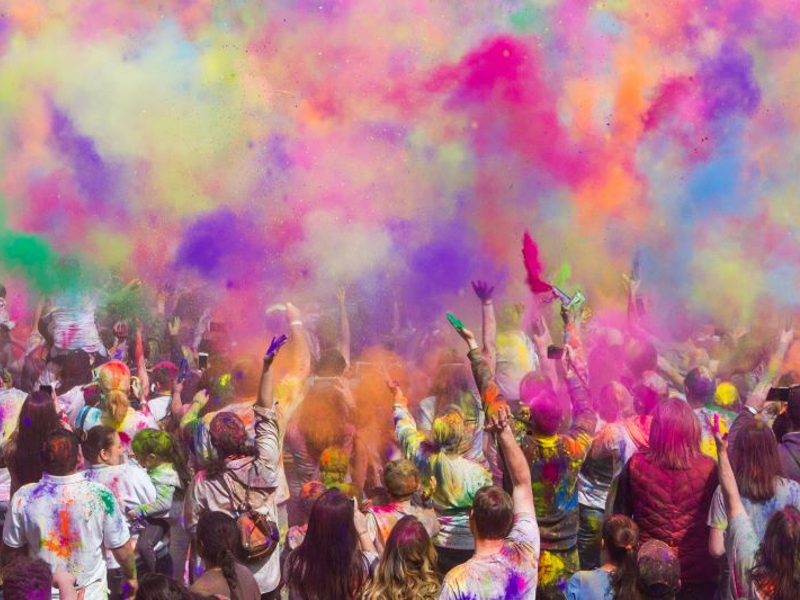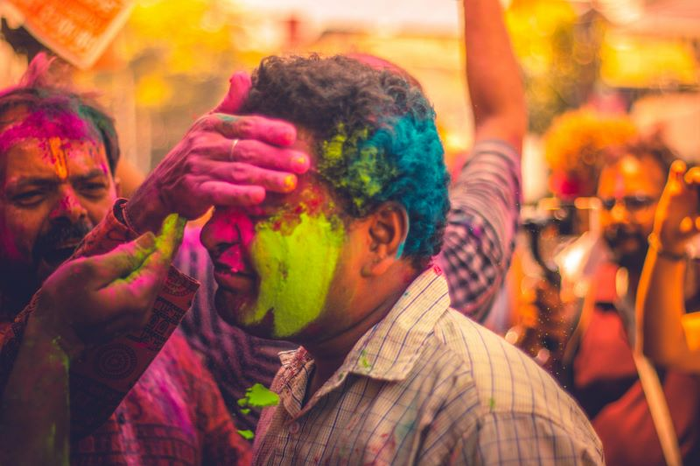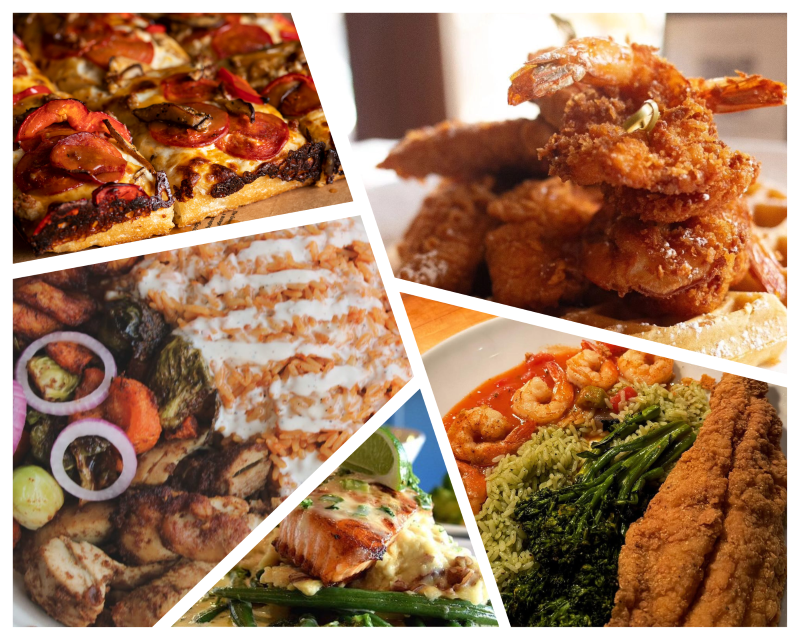
Holi festival in Spanish Fork, Utah. Photo by John Thomas on Unsplash
Holi, the vibrant Indian festival of colors, is a celebration marking the beginning of spring after a long winter and signifying the triumph of good over evil. Holi is a festival celebrated annually around the end of February or early March. The exact timing varies a little in correspondence with the Hindu calendar’s month of Phalguna. For example, in 2023, Holi began on March 8. But in 2024, the holiday will be on March 25.
Holi, the only time it’s socially acceptable to look like a rainbow exploded on you, takes place in a variety of countries all over the world. Though originating in India, the festival has transcended borders, bringing its joyous spirit to those celebrating.
Holi has been celebrated since time immemorial in India, and like many ancient holidays that are still actively celebrated today, there are different versions of the Holi story. One common and popular version is that Hiranyakashipu, a demon king, became so powerful that he forced his subjects to worship him as a god. However, his son Prahlad was a devotee of Lord Vishnu and refused to follow the order. This got the king angry, and he plotted with his sister Holika to kill his defiant son. The sorceress created a bonfire, planning to burn Prahlad to ashes. However, the boy survived, and the evil Holika met her end in the fire. Holika’s name is where Holi gets its name, and is said to mark her defeat and the triumph of good over evil forces.
How Holi Is Traditionally Celebrated

Photo by Aneesh Ans
In India, this period is a time to let loose and celebrate life. In the days leading up to the festival, the streets are lined with stalls selling powdered colors, pichkaris (water pistols), and other festival-related paraphernalia.
On the eve of Holi, some communities begin the festivities by lighting bonfires in a celebration known as Holika Dahan, or Choti Holi to signify the burning of evil spirits. Songs and dances take place around the bonfire. Various items are often thrown into the flames, including wood, dry leaves, twigs, and even roasting grains, popcorn, coconuts, and chickpeas. Once the bonfires have gone out, some Hindus smear the ashes on their bodies as a purifying ritual.
However, Holi’s signature tradition is the throwing of colored powders, as such, no one wears their best clothes. People take to the streets, fully immersing themselves in color from head to toe. Family and friends gather to playfully throw colorful paint and bright powders at each other and into the air. A troupe also plays a traditional wooden drum called a dhol while dancing amid the colors. Each color carries a different meaning during Holi.
- Red – the color symbolizes love and fertility.
- Yellow – the color of turmeric, a powder native to India and used as a natural remedy is both a symbol of health and native pride.
- Blue – this represents the Hindu God Krishna.
- Green – symbolizes new growth and new beginnings.
Another aspect of the festival is the throwing of water from the streets and the rooftops. After all the color and water throwing, a feast usually follows, with traditional foods like gujiya (a deep-fried sweet with dried fruit), dahi bhalla (a yogurt dish garnished with savory chutney), and lassi (a chilled, refreshing yogurt drink), to name a few. People also exchange candies and sweets with loved ones, neighbors, and friends.
Holi Celebration In America
The color festival is most popular in India, but Holi celebrations also happen around the world. Originally, Holi celebrations in the US were limited to South Asian Hindu communities wanting to preserve their cultural connections to home. Today, people of all ethnicities and cultures join in.
While not a traditional American holiday, Holi has gained immense popularity in recent years. It has found a new home in the US, especially in cities with large Indian populations. The festival is celebrated with gaiety and a lot of fanfare across different cities.
New York City: The city sees lively Holi celebrations with large-scale events in Central Park and Flushing Meadows Corona Park. Some of the attractions are parades, and the addition of dances, fashion shows, and music concerts. This attracts thousands of participants, transforming the landscape into a sea of colors.
Los Angeles: Popular venues like Wickham Park and Balboa Park host events featuring music, dance, delicious Indian food, and of course, the colorful throwing of gulal. California’s sunshine sets the perfect backdrop for Holi celebrations.
Houston: Holi is also one of the largest South Asian events in Houston, with huge parties thrown across the city. Festivals held at India House and Mahatma Gandhi District attract thousands of event-goers. The large crowd enjoys energetic music, dance performances, and a chance to experience the joy of Holi firsthand.
New Jersey: This is a Holi hotspot because of its significant Indian population. Many Holi festivals are hosted across the state in March.
Chicago: Just like in India, the “Windy City” embraces Holi with the same colorful, playful, family-filled fun and devotion. Families come together to create colorful memories and enjoy traditional Indian sweets like Gulab Jamun.
San Francisco: Holi is a great deal in San Francisco. There is an array of exciting events including festive colored Holi powders, live music, dance, and delicious multicultural food. From rain dancing to beach party, there is a lot to look forward to this Holi.
Utah: Spanish Fork, Utah, hosts a Holi celebration. It’s based at the local Krishna temple. Attendees are invited to throw a handful of their colorful powder to the wind at the top of every hour and join in the celebration of the event.





